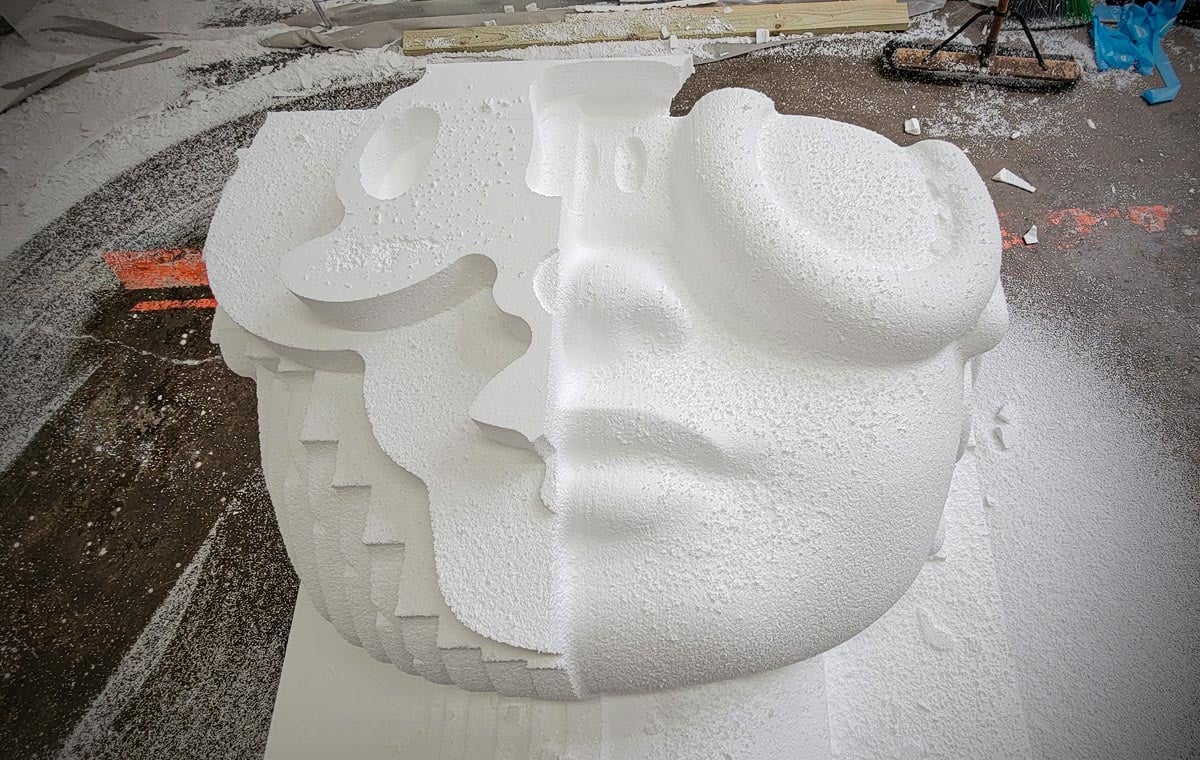Artists and creators have always used a variety of materials to expand their capabilities and bring their concepts to life. From found objects to custom paints and materials made by hand, where there is a will, the artist will find a way. As materials technology advances, the reservoir of materials available deepens allowing conceptual artists to experiment, explore and realize their visions. Using foam for sculptural fabrication is a prime example of this expansion.
Foam has many advantages over other materials, particularly for experimental and large-scale works. Foam sculpture enables artists the capability to build big, and experiment with shape and texture easily and affordably. The material is lightweight, can be worked using hand or machine tools, and accommodates a variety of finishes.
In this article, we’ll explore what makes foam the material of choice for many modern artists, and the tools they use to transform foam into amazing sculptures.
What are foam sculptures?
A foam sculpture is a three-dimensional artwork that takes its shape from carved foam, with its outer surface often receiving a hard coating to provide a desired finish. Foam sculptures are made using subtractive methods, including computer aided manufacturing (CAM) methods such as CNC milling or laser cutting. Like other types of three-dimensional art, it may be designed for viewing from a distance or up-close, from all sides or a single point of view.
While foam sculptures may be any size, they are often large pieces. For example, Artist Hebru Brantley used foam to create a series of larger-than-life sculptures of his iconic Flyboy character.
Foam sculptures may be carved from a single piece of substrate or assembled using multiple pieces, and constructed with or without the support of an armature.
The many ways in which foam can be used to bring an artist’s concept to life is one reason for its popularity. But it’s not the only one.

What kind of foam do artists use to build sculptures?
While it is possible to use extruded polystyrene (XPS) as a sculptural substrate, most artists prefer to work with expanded polystyrene (EPS). Both of these foams are made from a polystyrene resin but are manufactured using different methods that impact the end material’s performance.
XPS is made using an extrusion process that results in a denser material and is most often available in boards or sheets. A well-known XPS brand is Styrofoam. Don’t let this name fool you. Many people use the term “styrofoam” when referring to EPS.
EPS is manufactured from beads that are expanded using heat and a blowing agent. This process allows EPS to be molded into a variety of shapes and sizes during its manufacture. EPS can be produced in varying densities. By volume, only 5% of an EPS block is plastic with air filling the remaining space.
What makes EPS the artist’s choice? This type of foam costs significantly less than XPS and is available in blocks as large as 4’ x 3’ x 8’ which are more suitable for carving than XPS’s flat boards.
8 reasons artists choose foam for their sculptures
- Foam is a lightweight material, making it easier for artists to manipulate and move a sculpture during fabrication and transport and install the finished work.
- The material is cost-effective compared to other substrates and readily available to most artists through local stores or specialty manufacturers. (It costs much less to ship a piece of foam than a piece of granite.)
- A soft, yet rigid material, EPS can be carved using simple hand tools, saws, hot wire, CNC machines and other equipment.
- EPS is non-toxic and chemically inert making it safe to handle. EPS Foam doesn’t degrade or absorb moisture, so sculptures made from foam remain stable over time. Adding fire and weather-resistant coatings to your completed sculpture further ensures its longevity.
- While your local recycling center may not accept EPS, the material is recyclable. The EPS industry has developed a global recycling program to facilitate the reuse of EPS.
- EPS accommodates a variety of coverings and finishes giving artists near-limitless possibilities for exploring color, texture, and light in their works making it an appealing material for all kinds of art installations.
- The low cost, versatility, and light weight of foam empowers conceptual artists to craft large scale, multi-part projects that fully realize their creative vision.
Is foam sculpture different from fiberglass sculpture?
While foam and fiberglass are good choices for large-scale sculptures because the materials are lightweight, they are definitely not the same. Foam sculptural fabrication is a subtractive process. Pieces of the foam are removed to shape the work. Fiberglass sculpting requires several steps that may involve subtractive and additive processes depending on the materials selected by the artist.
To create a fiberglass sculpture, the artist must first make a form representing the object they want to produce. This carved piece is then used to create a negative mold, often out of silicone. This mold must capture all the details of the carved object, and often, separate molds must be made for parts of the object.
These are used to form the fiberglass parts which are then pieced together–remaking the object represented by the original carved master. Once each mold is created, they are filled with a layer of liquid resin and fiberglass. The fiberglass may be added in particles or sheets. This is the casting step which, when complete, results in a fiberglass sculpture that must be finished using methods similar to those that are used to finish foam sculpture. A sculptor might use this multi-step process when they wish to use a non-durable material such as clay to create the positive mold.
By choosing to work with foam, artists can eliminate the need to produce a set of negative molds for shaping the fiberglass and instead add finishes to their original foam sculpture.
How do artists sculpt with foam?
Beginning with a block of foam, the means of shaping it are nearly endless. Artists can shape foam using freestyle carving techniques, altering their design as they proceed, or develop a full design and build a digital model before their first cut. A sculpture may be crafted from a single block of foam or several blocks placed on an armature or sealed together.
Using CNC fabrication, artists can design, test, and modify their work before they begin to build. Their final concept becomes a computer-aided manufacturing (CAM) file that is executed with precision by the CNC machine.
3D foam objects can be treated with smooth or textured finishes that add additional visual interest and dimension to the work.
How can you create your next great sculpture with foam?
You don’t have to have a CNC machine or access to giant foam blocks to build a foam sculpture. But if you plan to go big, it helps to have access to the right tools and materials. A full-service design and fabrication company can provide you with the knowledge, technology, and tools you need to take your concept from idea to installation.
At Bridgewater Studio, we've been partnering with artists to bring their creative works to life - at scale - for decades. From Hebru Brantley's iconic Flyboy to Ashley Longshore's Flower Chairs and oversized mushroom sculptures, we collaborate with artists to precisely replicate their works of art using the best means, methods, and materials for the project. Learn more by booking a no-obligation Strategy Session with Bridgewater today.


.png)
.png)
.png)







